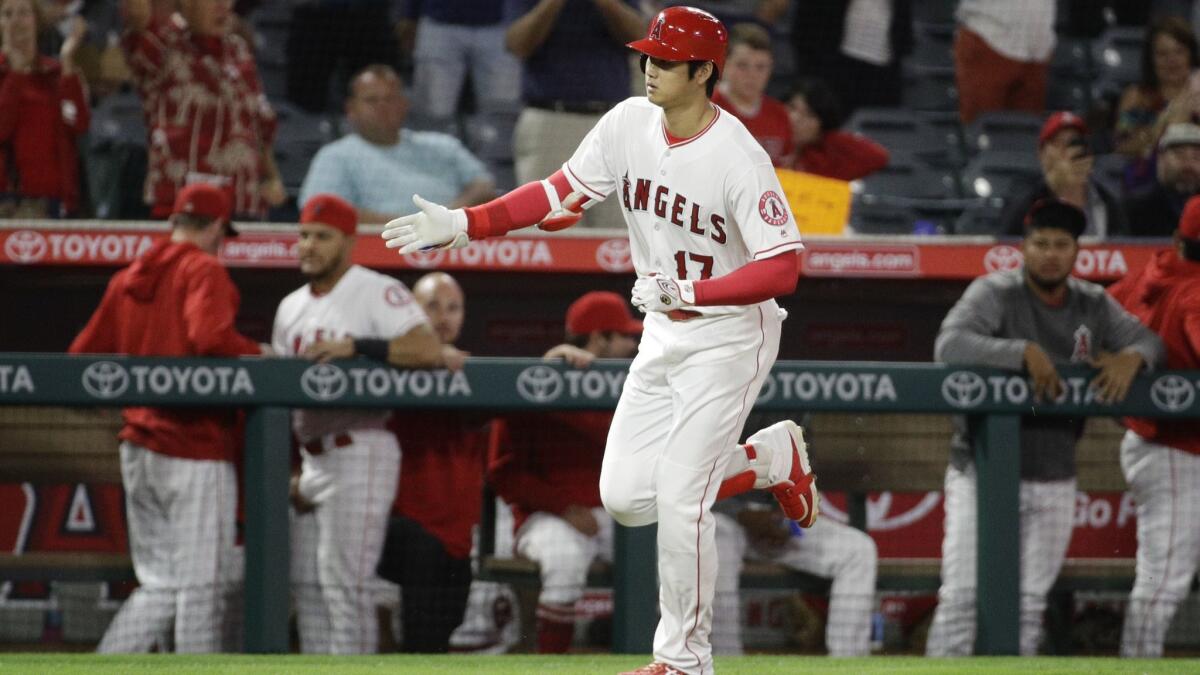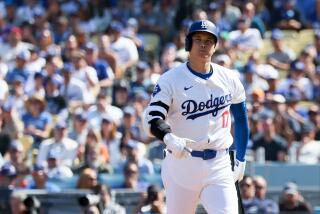Angels’ Shohei Ohtani to undergo Tommy John surgery next week, but he is optimistic about future at the plate

- Share via
For weeks, the choices bounced around in Shohei Ohtani’s head.
The Angels’ two-way star had known since Sept. 5 that the damage to the ulnar collateral ligament in his right elbow was too severe to be healed by stem cell injections or plasma treatment.
His shredded elbow needed to be mended by a surgeon.
If he took the recommendation of the team’s medical staff, Ohtani would have to give up pitching for the entirety of his second major league season. He’d be limited to hitting in 2019.
The situation was not ideal for a 24-year-old who had committed years ago to take a path few had traveled at baseball’s highest level. It took some time, but Ohtani eventually acquiesced.
Twenty days after first learning his fate, and just hours before they beat the Rangers 4-1 for their second win in a row to start a season-ending homestand, the Angels on Tuesday announced Ohtani will undergo UCL reconstruction surgery, or Tommy John surgery, in Los Angeles next week.
Dr. Neal ElAttrache, a renowned orthopedist, will perform the procedure.
“I am disappointed at the fact I am not going to be able to pitch next season but I’m trying to take positives out of negatives,” Ohtani said through interpreter Ippei Mazuhara after the game.
“Normal players — players that only pitch or hit — wouldn’t be able to play at all next season. But fortunately I have the luxury of being able to play as a hitter next season, so I’m just trying to take positive stuff out of that and try to help the team in as many games as possible as a hitter.”
Ohtani already had spent time on the disabled list in June nursing a sprained UCL. He had been the Angels’ most effective starter to that point in the season. He’d held batters to a paltry .202 average, striking out 30.5% of them.
In a world where pitchers’ victories barely matter, Ohtani had emerged victorious in four of nine starts. The Angels were 7-2 when he took the mound, which allowed them to remain within six games of the Houston Astros and Seattle Mariners, who were jockeying for the division lead in the American League West, through the first week of June.
Then the list of Angels pitchers sidelined with various ailments continued to grow. The Angels’ efforts to keep pace in the divisional race were thwarted by the Mariners and upstart Oakland Athletics and their own inability to stay healthy.
Ohtani’s misfortune came at an inopportune time. The Angels will never know what might have been had his elbow not barked at him during his last home start June 6. He left the game after holding the free-falling Royals to one run on four hits in four innings.
At least the Angels already have gotten a taste of what can happen when Ohtani is left solely to his bat.
Ohtani returned to hitting in early July after treating the injury with a platelet-rich plasma injection and an injection of stem cells.
Free of the limitations he happily followed as a two-way player early in the season, Ohtani first struggled in July, then batted .328 with three doubles, six home runs and 18 runs batted in 24 games in August.
In the month after going 13 for 64 with five RBIs in 22 July games, Ohtani had launched himself back into the conversation for the American League rookie of the year award.
When he attempted to enhance the status of his dazzling debut season, Ohtani lasted only 21/3 innings in his return to a major league mound Sept. 2 in Houston.
The velocity of his fastball had dipped from 98 mph to 89 mph in a span of three pitches. He allowed a two-run homer before departing in the third inning.
Days later, an MRI revealed new damage to the ligament. Ohtani has not pitched since.
Ohtani had a game-tying single in Tuesday night’s win. Hitless in his first two at-bats, Ohtani turned an ugly swing at a down-and-away slider from Rangers reliever Martin Perez into a bloop RBI single to center field that knotted the score 1-1. As the Angels sent nine batters to the plate, Ohtani also scored for the Angels in the four-run frame.
Ohtani entered the night batting .280 with a .925 on-base-plus-slugging percentage and a wins above replacement (WAR) of 2.6, according to Baseball-Reference’s version of the statistic, in 99 games. His 21 homers ranked fourth among American League rookies. Meanwhile, his 3.31 ERA and 63 strikeouts in 512/3 innings had helped him accumulate a 1.2 WAR as a pitcher.
“It’s been a small sample size of just one season, so I can’t really say that I’ve proved to the world that I can continue being a two-way player,” Ohtani said. “But I need to continue improving each year and hopefully I will be able to prove that I can continue as a two-way player.”
Although he won’t be able to pitch competitively again until 2020, Ohtani is expected to return as the team’s designated hitter in 2019, a role he’ll likely split with Albert Pujols. It’s impossible to say now how quickly he’ll bounce back in his recovery from surgery, though the Angels are optimistic about Ohtani being ready in April.
Regardless of when he’s cleared to return to the batting order, Ohtani’s journey at the plate next season will continue to be a captivating storyline.
“I think that he put all his focus into hitting once he knew he wasn’t going to be pitching this year,” manager Mike Scioscia said. “… I think he’s at peace with it and he’s focused on hitting.”
More to Read
Go beyond the scoreboard
Get the latest on L.A.'s teams in the daily Sports Report newsletter.
You may occasionally receive promotional content from the Los Angeles Times.








